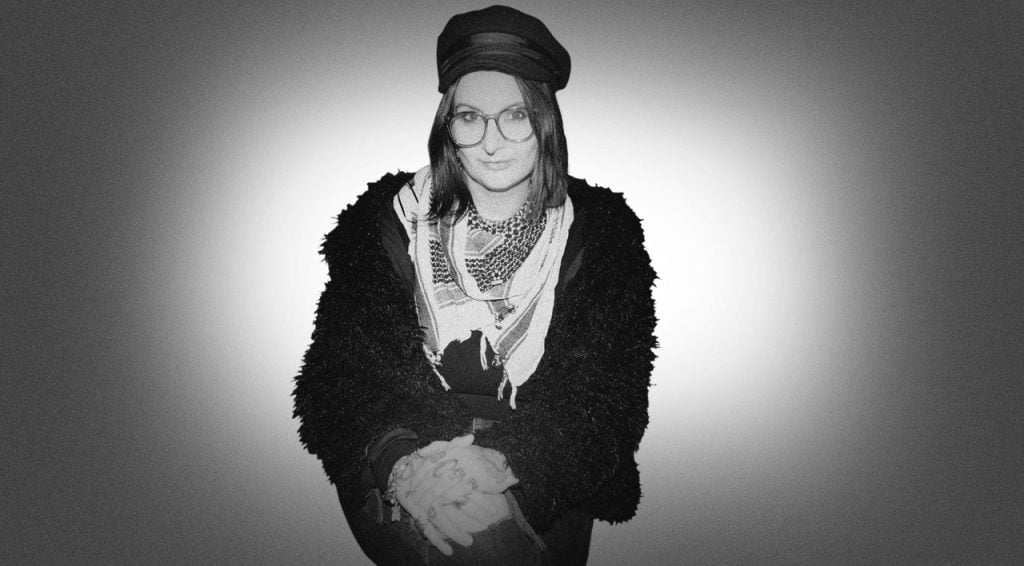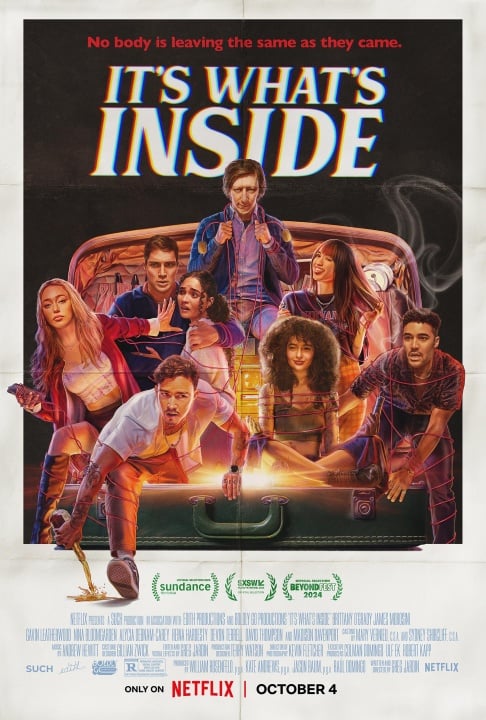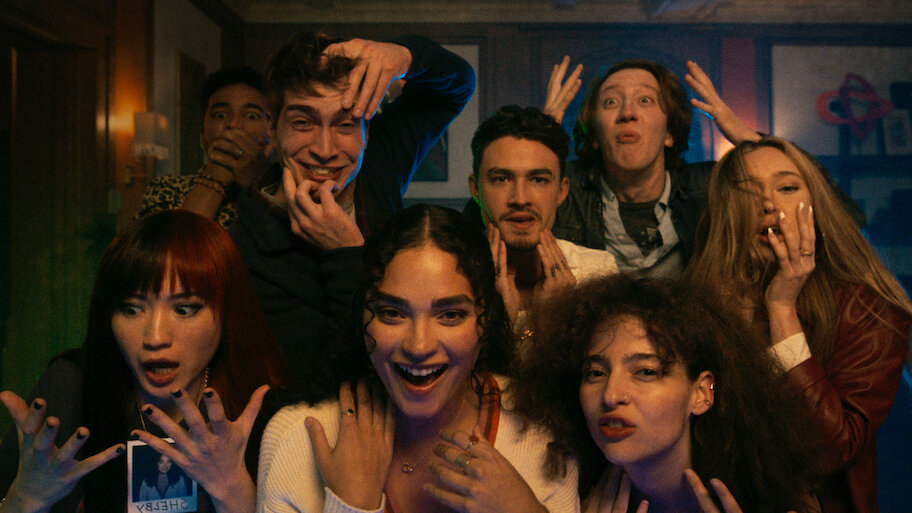The body swap genre has captivated audiences for decades, with Freaky Friday (1976) often hailed as one of the first iconic films in the category. Over the years, this premise has been explored in various ways, from comedies like Big, The Hot Chick, and 13 Going on 30, to more recent hits like Freaky and Family Switch. Another standout in the body swap genre is Netflix’s It’s What’s Inside, which offers a fresh and bold take on this familiar concept. The film follows a group of college friends who reunite for a party eight years after their last get-together, only for the night to spiral into chaos. Unlike many of its more lighthearted counterparts, It’s What’s Inside delves into the darker side of body swapping, as the characters grapple with their new bodies, strained friendships, and complicated emotions, including jealousy, unrequited love, and unresolved past relationships.
There are many aspects that stand out about It’s What’s Inside (which is why Netflix bought it for $17 million at Sundance), but one worth mentioning, when knowing the backstory, is the film’s makeup. Claire Amadea served as the makeup head for the film and did everything from tattoos to broken neck prosthetics. When discussing the film’s makeup, Claire says, “Makeup sometimes gets thought of as just being a little bit of powder which is really reductive and inaccurate – there is a ton of design work, creativity, and planning that goes into everything, even the seemingly smallest and least important elements. In this instance, not only did we decide on what makeup everyone would have on their faces or how the men’s facial hair was groomed, but we did extensive planning and design for nearly 100 tattoos on two characters.”
Claire reveals more about It’s What’s Inside in the below Q&A.

Where did your love of horror and science fiction come from? What was the first science fiction movie you remember watching?
I grew up on a steady diet of classic horror and science fiction literature and film, thanks to my mother. She was an English literature teacher, and introduced me early to the Universal monster movies, where I learned that having the pants scared off of you can be a good time, actually (7 might have been a little young for some of them). Technically the very first science fiction movie I watched would have been Frankenstein. Mary Shelley really defined the genre, and I saw that before I saw most anything else.
Star Trek: The Next Generation was nightly watching for us, and my first introduction to the Alien franchise was through a traveling exhibit at our local science museum of sci-fi pop culture. Coming face to face with the life size Xenomorph Queen and a power loader as a small child is not something you forget. My friend group was also very into sci-fi, and we would devour anything we could get our hands on. One of my friends introduced me to Event Horizon and I realized that horror sci-fi was really my genre. I was really fortunate to get to work with Kathleen Quinlan a few years ago and she very kindly tolerated me being a massive nerd about that one.
You have said that you like to create custom prosthetics when working on a project. How do you go about creating a custom prosthetic?
I love making custom pieces. Nowadays, we’re really lucky to have companies like RBFX Prosthetics, Out of Kit FX, and Dyad FX with massive catalogs of pre-made prosthetic pieces, but being able to make something fully custom means much more creative control. There are many ways to go about it, but the main gist of it is concept → sculpture → mold → cast → paint/apply. There are a ton of different materials to use, depending on what you’re making and what its intended use is. For example, I wouldn’t suggest using gelatin or silicone for a creature suit, or a pros aide transfer on a joint that has a lot of movement, but foam latex is great for creature suits and pros aide transfer make a great option for subtle aging pieces or wounds.
In a perfect world, you’ll take a life cast of the performer the makeup is going on and sculpt directly onto that in order to get the perfect proportions and use the life cast as the positive when casting the piece to make sure it fits like a glove. Sometimes that’s not in the cards though, and you might use a generic life cast form or even sculpt something on a flat board.
Did you do anything custom for It’s What Inside?
For It’s What’s Inside, I didn’t make anything from scratch aside from the tattoos, but I did use a mold sculpted and made by my friend, the amazing Ken Calhoun, and cast up a piece for use on Nina Bloomgarden/Maya for her death scene. It was an encapsulated silicone “broken neck” prosthetic. Silicone is really versatile but one of its features is that nothing sticks to it, so if you want to be able to paint on top of it, you sandwich it in between thin layers of bald cap vinyl. Also, broken necks don’t actually look like anything in real life, but for visual drama, we opted to suspend disbelief a little bit and make her neck distorted from the injury.
For the tattoos, I did graphic design work and fabrication for pieces on both Dennis (Gavin Leatherwood) and Maya.
How long was the shoot for It’s What’s Inside?
We filmed for 18 days. Most of it was in one location, this incredible house and its grounds in Portland, plus two days in a sound stage and one on location for the driving segments and a scene that ultimately got cut. I also had a couple prep days before filming began, where I did makeup tests with the actors, set up our work space, and my key and I did shopping for supplies we would need for filming.
I imagine that when characters are shooting a scene, sometimes the prosthetics can getmessed up. Were there any problem prosthetics on It’s What’s Inside?
Not really. The prosthetics only shot for one day, and even then, it was only one scene and a handful of shots. There wasn’t really an opportunity for that to happen. That said though, one of our jobs as makeup artists is to keep an eye on the makeup and do any touch ups or repairs necessary to keep everything looking good. We did run into this with the tattoos sometimes, and had to clean things up because the tattoos can sometimes get sticky and pick up detritus or we’d have to touch them up because something was in a friction point and got rubbed off.
We heard there is a whole backstory for some of the character’s tattoos in the film? Can you discuss some of this?
Makeup sometimes gets thought of as just being a little bit of powder which is really reductive and inaccurate – there is a ton of design work, creativity, and planning that goes into everything, even the seemingly smallest and least important elements. In this instance, not only did we decide on what makeup everyone would have on their faces or how the men’s facial hair was groomed, but we did extensive planning and design for nearly 100 tattoos on two characters.
Dennis (Gavin Leatherwood) has 28 individual tattoos from his knuckles to the back of his neck. I even had pieces pulled for if his character appeared shirtless, but those ended up being unused. Dennis is a trust fund kid that wants to be a rapper, and does everything he can to project a cool, tough persona. I worked closely with Gavin to develop his look, and that included every single tattoo choice and placement, as well as discussing why Dennis might have chosen the design and where it is on his body. I’m also heavily tattooed myself, and I leaned into my experience in tattoo culture. It used to be you couldn’t really get a hand or a neck tattoo without already having a bunch of work done, but as the years have gone by and tattooing has become more mainstream, you see a lot of kids these days whose first tattoos are large and in highly visible locations. We decided Dennis was definitely one of those kids who got a huge neck or hand tattoo as his very first one, so even in the flashback sequences, his neck tattoo is clearly visible. His knuckle tattoos read “HOME SICK” and he also has a large custom chest tattoo I made for him that says “FORGIVEN,” because above all else, Dennis thinks he’s super deep and thoughtful and is oblivious to the harm he’s done, especially within his own friend group. I also have a silly thing I like to do where I hide one of my own tattoos in a character’s design – no one else knows it’s there or will see it 99% of the time, but I know it’s there and it makes me smile – so Dennis has a small skeleton key tattoo tucked into the jumble on his arm.
Maya (Nina Bloomgarden) is explicitly described in the script as being covered in ink, and she ultimately ended up with 63 total pieces. When you bring your entire back stock catalog of tattoos to the makeup test, and the director says “more,” you start problem solving. Maya is a free spirit, nomadic type, and our thought was that she gets a new tattoo or three wherever she lands, so there wouldn’t be a consistent style or cohesive design, and that she’d end up with a collection of patchwork pieces. I can’t say much – that’s 100% how my tattoos are too. This gave us a lot of freedom for what we could incorporate. While there were a few pieces specifically called out in the script, beats we had to hit, I pulled in inspiration from all sorts of places like pop art styles for the custom work. Nina also had an absolutely brilliant suggestion/request, and pitched that we incorporate doodles and artwork by her late father. I loved it and found it so incredibly touching. She sent me a selection and I went to work, pulling them into a drawing program to lightly edit them to make them look more like tattoos. I then turned them into sheets of temporary tattoos, and they are very visible on her arms. I love that we were able to do that for her.
Can you explain your process for choosing makeup based on lighting conditions? Did you have to do any of this in It’s What’s Inside?
Color theory and lighting are a huge part of our job as makeup artists, and our conditions on this were a bit unique. There’s key narrative tool surrounding RGB artwork – where you use colored gels to reveal different designs in the same piece – that Greg Jardin (director) and Kevin Fletcher (DP) used to help us follow the body swapping. Different colored “panes of glass” (which we achieved with lighting gels) would help reveal who was in whose body, allowing us to follow the characters better. This means, though, that any of those colors used in the makeups would also be canceled out, much like how the art technique works, so we had to take that into consideration. Mostly, we just made sure things would work universally through regular lighting and also through red and green gels, but sometimes we’d have to adjust on the spot as well. Fortunately, the lighting was all practical rather than having to guess how it might come out in color grading so we were able to keep it looking consistent.
What are your strengths as a makeup artist?
I’m really adaptable and good at thinking outside the box. I came up on really tiny, no-budget indies and worked in the haunted attraction industry so my background is in figuring out how to make something out of nothing. The shows I came up on frequently didn’t have money to spend on complicated makeup elements, so I had to figure things out on the fly and used my background in painting and illustration to make things look good. Working in haunted attractions made me fast and gave me a really broad skill set. When you’re cranking through 100 actors in a couple of hours with just a few people, you learn how to be extremely precise and how to get the biggest bang for your buck in the shortest amount of time. I cannot recommend that industry highly enough to makeup artists starting out. It’ll also teach you how to do impactful character makeups without prosthetics.
I study and learn constantly, whether that’s reading books or interviews, watching videos, learning on the job from other artists, or going back to school for a variety of subjects. Everything I do is with the intention of being better than I was on the last job. There are some really incredible shows on the ballot for Outstanding Contemporary Makeup this year. It’s an honor to have our work on It’s What’s Inside be included alongside shows and artists like Zoe Hay/Paradise, Donald Mowat/Presumed Innocent, American Horror Story, The White Lotus, and more. It’s really validating to know that me being the huge makeup nerd I am and closely studying everyone who came before is paying off like that, even if I still feel like a little bit of an impostor being in the same room with all of them.
I’m also really chill and even-keel for the most part. Not to say I’m entirely unflappable, but I’m good in high pressure, high stakes situations and I don’t freak out easily. When you’re running a department, you’re answering to everyone. You’re the liaison between your team and production, you answer to the director, the actors come to you with issues, plus you have to know exactly what’s happening in what scene on what day at all times so if someone has a question you can answer it, and all the responsibility is on you if something goes wrong, so if you overwhelm easily, it’s maybe not the job for you. I’ve worked for department heads that expected the team to take the fall if something went wrong to keep the department head from looking bad, and I decided that’s the opposite of how I wanted to operate. I believe a huge part of my job is looking out for my team.
There are now AI-powered tools that enable virtual makeup try-ons and design that help you decide a certain look for a character ahead of time. Have you experimented with this at all?
Absolutely not. I think generative AI is a plague and is the death of creativity. It’s lazy, it’s based entirely on plagiarism and theft, and it exists solely to kill jobs. I want nothing to do with it. The only problem it solves is the issue of wages and labor. Virtually all the data sets that exist were created without the consent of creatives whose work was scraped to feed the machine learning. Where’s the creative challenge in telling a computer program what I want? That’s not artistry.
Are there any makeup trends in the film and tv world right now you are following?
There’s an interesting focus on holistic approaches to character looks I find fascinating. I’m also an esthetician, which I incorporate in my makeup work, but reading about the looks for Barbie, there was a really illuminating interview with the makeup department head where they described even a dietary and nutritional component to creating the looks for Barbie Land. I’m really keen to learn more about that and see how I can incorporate that in the future, as well as a science-based approach to keeping everyone’s skin healthy through filming. It can be really rough, especially if someone has something like tattoos or prosthetics that are being applied and removed every day, so we a) always find the gentlest options to minimize sensitizing and irritation and b) find a protocol to protect the skin barrier and repair as needed.
Otherwise, I’m always watching the innovation and progress when it comes to prosthetic work. There are people doing incredible work, like Mike Marino, Vincent Van Dyke, and Barrie Gower. The work on the Penguin series on Colin Farrell is nothing short of astonishing, and I’ve been a fan of Barrie’s work since Game of Thrones and seeing what’s coming out of The Last of Us is always inspiring.


DC Fanboy! Superman is the greatest comic book character of all time. Favorite movies are Man of Steel, Goonies, Back To the Future







You’re making me want to watch it again!! I didn’t know it was filmed in Portland 😁